Looking for a great new way to expand your lead generation? An online challenge funnel could be precisely what you're looking for.
Free Reports, E-books and even E-courses just don’t have the same power to build your mailing list like they used to…
Your typical internet user has seen so many of these free opt-in offers by now, they tend to ignore them unless your value proposition delivers exactly what they're looking for.
So does this mean the free opt-in offer list building strategy is dead? NOPE...not at all!!!
However, it does mean you must start providing more value in your opt-in offers to make them stand out.
One of the simplest ways to achieve this is by transforming your free opt-in offer into an online challenge.
What is an Online Challenge Funnel and Why Should You Consider One?
If you're wondering what an online challenge is, just think of it as an email marketing strategy to provide visitors with a desired outcome (like learning a new skill) over a set number of days by following daily lessons and tasks you send to them via email.
Even though that sounds more complex than your typical lead magnet, it doesn’t have to take that much extra work to pull off.
By combining the power of your email marketing service, landing page builder (like Thrive Architect) and social media tools, you can create an engaging online challenge funnel that not only builds your list, but sells more of your products too!
Keep reading to learn how to set up your own online challenge funnel, and see how top players from different industries use online challenges to grow their mailing lists and boost sales.
How to Create Your Own List Building Challenge
So now that you’ve seen how four really successful – and profitable – list building challenges work across multiple online industries, it’s time to create one for your own online business.
Here’s how to get your first online challenge up and running:
1. Determine the benefit you’re going to craft your challenge around:
If you already have a paid product or premium online course available, think about how you can create a free challenge that would make selling your premium product a natural upgrade.
The feedback you get from your challenge participants will also help you find what they need additional help with and would be willing to pay for as a premium upgrade.
2. Decide how many days your challenge should run for:
We recommend keeping your challenge under a week long so you don’t get crushed by the massive amount of content longer challenges require.
5 to 7 days seems to be the standard length that industry-pros use. This length of time is better for rapid implementation and higher engagement rates. If the challenge is longer than a week, more of your participants will quit before they experience the awesome benefit you promised them...
3. Decide if you want to host a live hands-on challenge or an automated hands-off challenge:
Remember that live challenges require your continued involvement with all subscribers doing your challenge at the same time. This usually includes hosting live video sessions (via Facebook Live or webinars) and managing your participants (i.e. moderating your challenge Facebook Group).
This intensive live work is tough to keep up with, but can lead to better engagement from participants. If your challenge leads to a premium course offering – like in Coach Glitter’s case – it can really help boost your course sales when the challenge ends and you start pitching them.
Also, consider making your first challenge live and then automate the content you create from it for future challenges.
4. Decide whether you want your challenge to be evergreen or have fixed dates:
You can even make your automated challenge feel like it’s a limited time opportunity by refreshing the countdown timer each week – like in Ramit Sethi’s Save $1K in a Week Challenge example.
Fixed date challenges work much better to help promote limited time product launches like in Coach Glitter’s Live Video Confidence Challenge example.
5. Decide on your list building challenge technology:
At the very least, you’ll need to create a series of automated daily emails that begin on either a fixed challenge start date or the day people subscribe to your evergreen challenge.
If you decide to include social media tools (outside of social share requests) like Facebook groups, realize that it will be a full-time job to manage and moderate that social channel for the duration of your challenge.
Also, if you make your challenge evergreen, but decide to pair it with a Facebook group, you must commit to moderating it indefinitely. Otherwise, the group will have poor participation that will scare away new subscribers when they join.
6. Create a conversion focused landing page that gets new visitors to sign up to your list building challenge:
So guess what...that means you need one too!
BONUS: Because we’re such big fans of Ramit Sethi and learn a lot by analyzing his stuff, we went ahead and created a new List Building Challenge landing page template for Thrive Architect based on his Save $1,000 in a Week Challenge lead generation page:
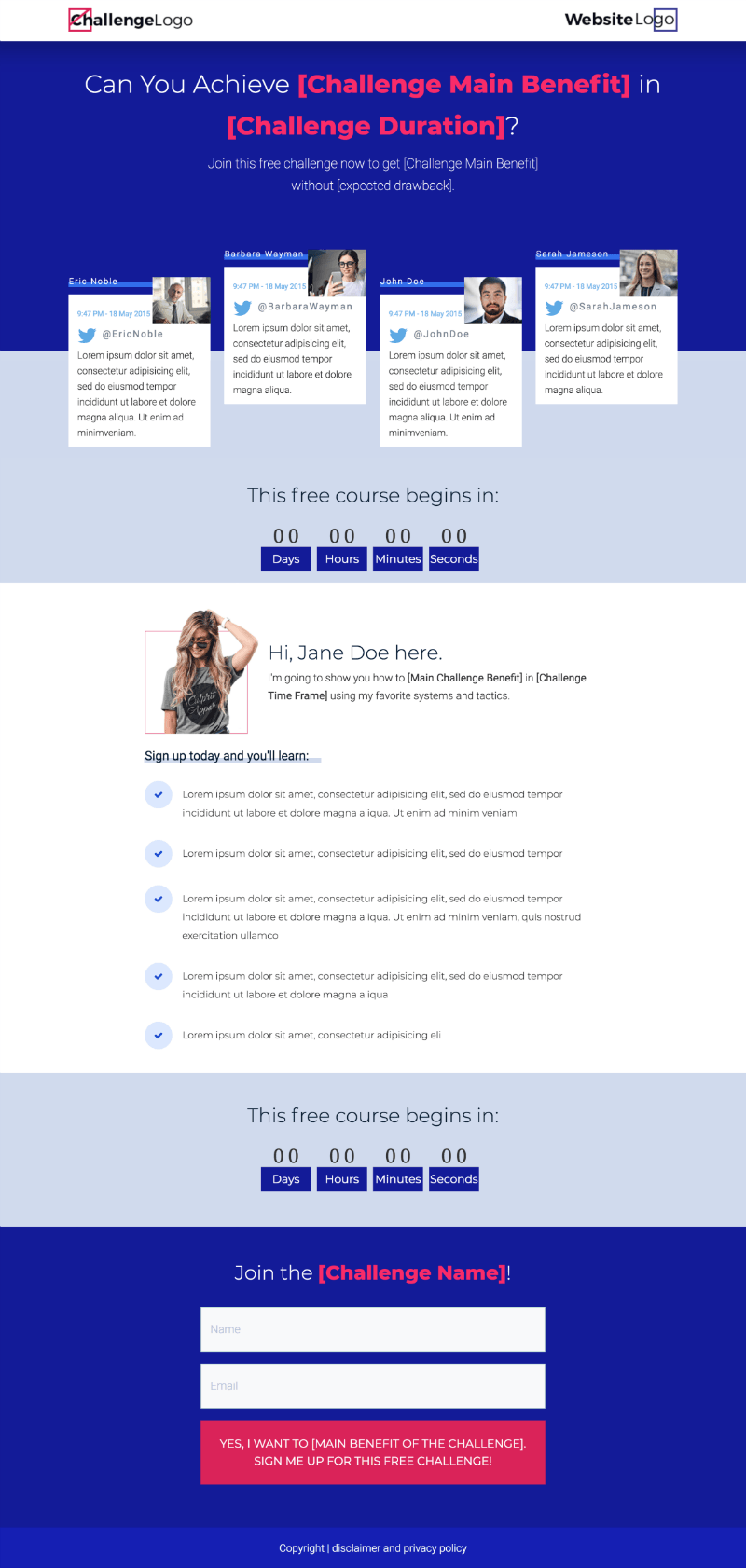
The new Thrive Themes "Email Challenge" Landing Page Template for Thrive Architect users.
If you’re a Thrive Architect user, you can find this new "Email Challenge" template within your Thrive Architect Landing Page Template Cloud. It's located in the Bonus category within Default Templates. You can learn how to load Thrive Architect Landing Page templates on your website here.
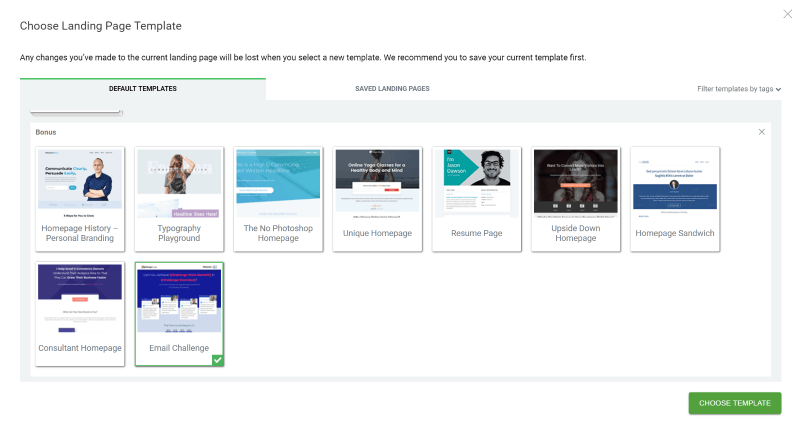
You can find the new Email Challenge Landing Page Template under the Bonus category of Default templates. Click here to learn how to load Thrive Architect landing pages on your website.
Just modify the template copy, upload your own images, change a few colors and VOILAAA...instant List Building Challenge Landing Page!
7. Promote your challenge:
Because it’s going to be such a super valuable resource for your target audience, you can start by informing the people that already know and trust you.
Encourage your friends and followers on social media platforms (Facebook, Instagram, YouTube, etc.) as well as your current email list to participate in your challenge and share it with their own friends and social networks. If you can establish a strong initial engagement, word of mouth and social sharing will help drive participation in your challenge.
If your list building challenge leads to paid product offerings, consider experimenting with paid traffic (like Facebook ads) to see if they can be profitable for you.
If you’re already a Thrive Themes Member – and logged in to your account!!! – you can listen to this exclusive audio to learn everything you need to know about launching your own Facebook ads.
If you’re not a member yet, you can check out AdEspresso’s Beginner’s Guide to Facebook Advertising here.
Finally, make sure to create and test different lightbox opt-in forms across your website to either direct visitors to your challenge sign-up page or get them to subscribe on the spot.
Of course, our very own Thrive Leads has everything you need to set up and A/B test high converting opt-in forms for your challenge. 😉
Examples of Successful Online Challenge Funnels
Ramit Sethi’s Save $1,000 In 1 Week Challenge
One of the all-time champs at list building is the online info-product master, Ramit Sethi. In fact, you can learn how to apply all Ramit’s list building strategies in a previous Thrive Themes blog post here.
Maybe it’s no surprise then that Ramit uses an evergreen challenge to grow his email list, all...year...long. It’s called The Save $1000 in 1 Week Challenge. You can see his challenge opt-in landing page below:
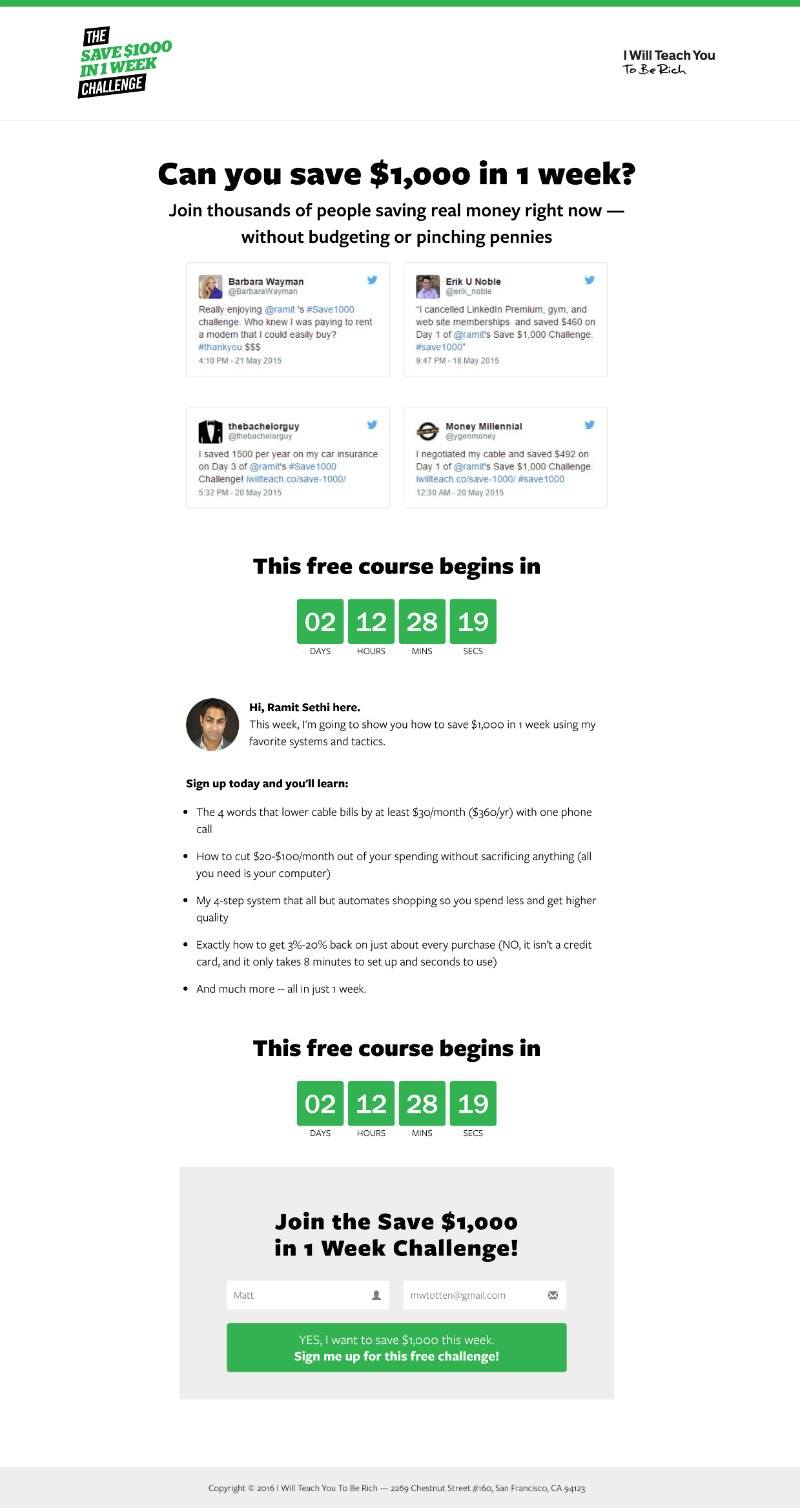
Ramit Sethi's Save $1,000 In 1 Week Challenge landing page.
After analyzing each piece of Ramit’s free Save $1K in 1 Week Challenge from start to finish, there are 5 key elements that comprise his challenge strategy:
1. Automated and Evergreen Online Course:
The challenge is a simple, 5-day online course that provides daily lessons and cost cutting assignments to participants. Each daily lesson has its own dedicated landing page on Ramit’s I Will Teach You To Be Rich website.
2. Email Automation:
Daily, automated emails are the primary outreach channel Ramit uses to engage his new subscribers after signing up. Links embedded in these emails bring challenge participants back to Ramit’s website to complete the daily lessons.
3. Basic Social Sharing Requests:
Social sharing is encouraged within both the automated emails and daily challenge lesson pages. Usually this is in the form of pre-filled, click-to-tweet Twitter messages as well as requests within emails to “Make [the challenge] fun by teaming up with a friend. Send [your friends] an email and invite them to join.”
4. Sales Pitch for a Premium Course:
Because Ramit is such a pro at creating high value online courses, the actual purpose of his free challenge isn’t just to build an email list, but to slow sell premium courses like Earn $1K On The Side.
I mean, if subscribers end up saving $1,000 from Ramit’s free challenge, then they’ll probably be eager to turn around and invest that in a similarly branded course that then helps earn them money…brilliant stuff, right?
Coach Glitter’s Live Video Confidence Challenge
Tiffany Lee Bymaster (a.k.a. Coach Glitter) is a Camera Confidence and Personal Branding Coach who uses a 5-day, Live Video Confidence Challenge to grow her email list. She then pitches a $497 Lights-Camera-Branding course at the end of her challenge:

Coach Glitter's Live Video Confidence Challenge landing page.
Coach Glitter takes a much more hands on approach to her Live Video Confidence Challenge than Ramit Sethi does. In fact, Coach Glitter’s challenge is only open twice per year instead of being automated and evergreen.
As you might expect from someone teaching a live video how-to course, Coach Glitter relies heavily on Facebook Live videos and a dedicated challenge Facebook Group to build personal relationships and encourage engagement from her new subscribers.
Although this live strategy requires a lot more work to manage and moderate, it likely creates a loyal group of true fans each time she runs her challenge.
Here are the main strategies Coach Glitter uses to execute her live challenge:
1. Live Challenge Launched Twice Per Year on Fixed Dates:
Coach Glitter’s Live Video Confidence Challenge is only open to join a set number of days before the challenge starts. The challenge only runs twice per year. Late signups are possible during the challenge, but not once it’s over.
2. Challenge Hosted on a Facebook Group with Long Daily Instruction Emails:
Once subscribers enter Coach Glitter’s challenge, they receive daily lessons via email that also ask them to join and participate on the Live Video Confidence Challenge Facebook Group.
The Facebook Group is where subscribers are held accountable to complete their challenge tasks presented in the daily emails. Coach Glitter also rewards participation by giving away daily challenge prizes within her Facebook Group.
3. Social Media and Paid Ad Traffic Generation:
Because Coach Glitter’s audience resides mainly on social media platforms like Instagram and Facebook, most of her Live Video Confidence Challenge traffic is through social shares and paid ad traffic.
She also requests her new subscribers to share the challenge sign up page with their “Go-Getter, like-minded, positive, highly driven, motivated entrepreneur friends” in her challenge signup confirmation email.
4. Sales Pitch for a Premium Course:
At the end of Coach Glitter’s free Live Video Course Challenge, she uses a series of follow-up emails and Facebook Live streams to pitch her premium $497 Lights, Camera, Branding course. Notice that Coach Glitter’s paid course is designed to feel like a congruent skillset upgrade to her free challenge.
If your list building challenge is a gateway to selling one of your premium products, make sure both are congruent with one another to reduce friction at the point of sale.
Nathalie Lussier’s Email List Building Challenge
Nathalie Lussier (pronounced Natalie Loo-see-ay) is a digital marketing strategist that created the 30 Day List Building Challenge as a way to...surprise, surprise...boost her own mailing list:
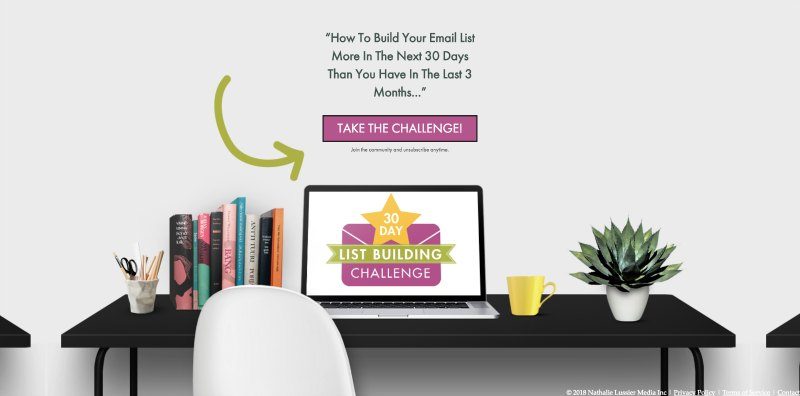
Nathalie Lussier's 30 Day List Building Challenge landing page.
This evergreen list building challenge starts whenever a new visitor signs up. Its ultimate purpose is to sell a subscription to Nathalie’s AmbitionAlly membership plugin along the way.
The fully automated 30 Day List Building Challenge is actually an online course hosted on the AmbitionAlly platform. This allows subscribers to experience the AmbitionAlly plugin front-end while learning how to come up with and create their own online course by the end of the 30-day challenge.
Purchasing the AmbitionAlly monthly membership then feels like a natural next step if engaged subscribers finish Nathalie’s challenge.
Here’s the breakdown of how Nathalie’s list building challenge works:
1. Automated and Evergreen Online Course:
The 30 Day List Building Challenge doesn’t use a countdown timer, but simply starts whenever a new visitor subscribes. The challenge is 30 days long, which is both long for participants and requires crafting a ton of email and lesson content for Nathalie.
The course is hosted on Nathalie’s 30DayListBuildingChallenge.com website using the AmbitionAlly membership plugin to facilitate the online course.
2. Email Automation:
The 30 Day List Building Challenge uses an automated set of emails that are sent daily after new participants subscribe. The emails briefly tease what the daily email is about and link back to that day’s lesson hosted on Nathalie’s site.
3. Social Sharing Requests:
Because each day’s challenge lesson uses short 2 to 5 minute videos, Nathalie makes sure to encourage the social sharing of her challenge by ending each video with “A rising tide lifts all boats so please share this 30 Day List Building Challenge with your friends and colleagues because as they grow their lists, so will you...and it’s great accountability too.”
She also presents several social media sharing buttons at the bottom of her daily challenge lessons and requests the sharing of her challenge in many of her daily emails.
4. SEO and Paid Ad Traffic Generation:
Because Nathalie’s challenge is pretty meta – building her list by teaching others how to build their mailing list – she dominates the search engines when people search for “List Building Challenge”. That means her challenge likely gets a lot of organic traffic, however Nathalie uses paid Facebook ads as well:
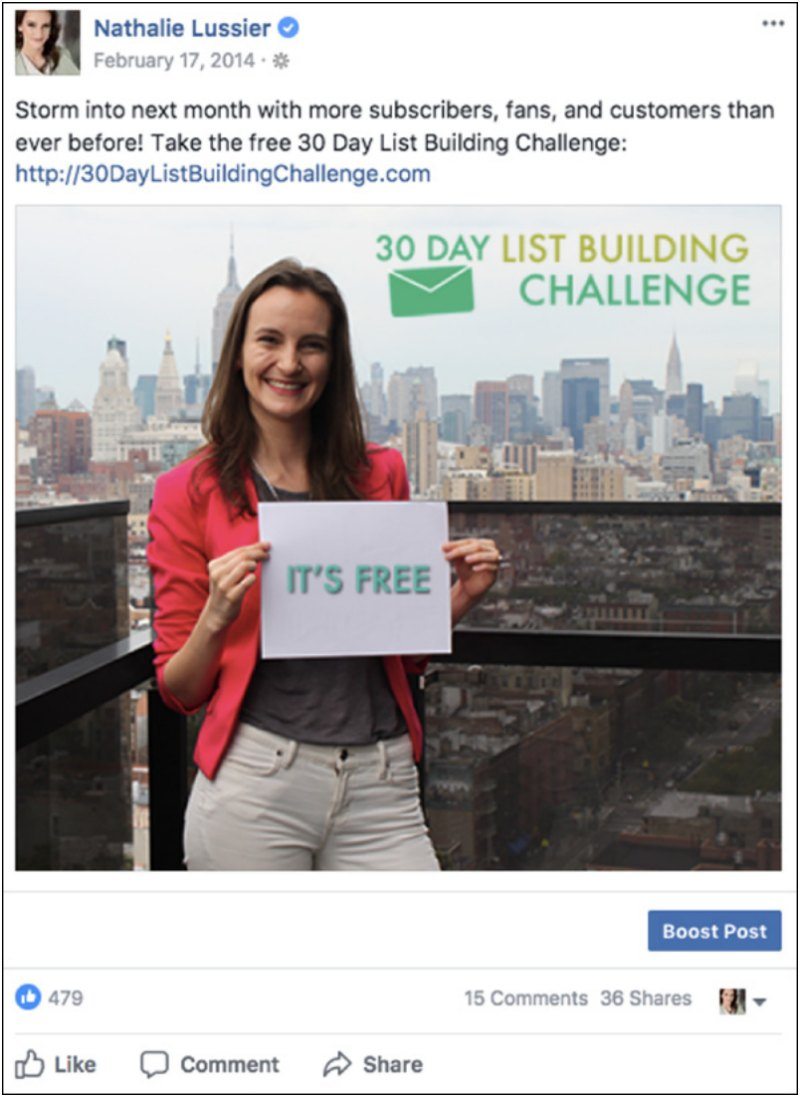
Nathalie Lussier's 30 Day List Building Challenge Facebook Ad used to drive paid traffic to her challenge sign up landing page.
5. Tripwire and Membership Plugin Subscription Sales:
Although running a 30-day list building challenge is difficult to both execute and keep participants engaged, it provides an opportunity to sell subscribers the entire course upfront instead of being drip fed each lesson’s content day-by-day.
That’s why Nathalie uses a tripwire (i.e. a low priced product offer) to give subscribers a chance to purchase instant access to her entire challenge after signing up. She writes that these instant access tripwire sales cover her Facebook ad spending by a 4 to 1 margin!
Finally, Nathalie ends up cross-selling her AmbitionAlly membership plugin subscriptions to her 30 Day List Building Challenge subscribers throughout the duration of the course.
Yoga With Kassandra’s Yin Yoga Immersion Challenge
Kassandra Reinhardt runs the world’s most viewed Yin Yoga YouTube channel, with over 6 million views and 85,000 subscribers. Needless to say, most people who come across her yoga instructional material find it through YouTube.
That said, Kassandra has her own website where she grows her email list to sell a range of premium products including retreats, paid courses and books. Kassandra’s top list building strategy is her 7 Day Yin Yoga Immersion challenge:
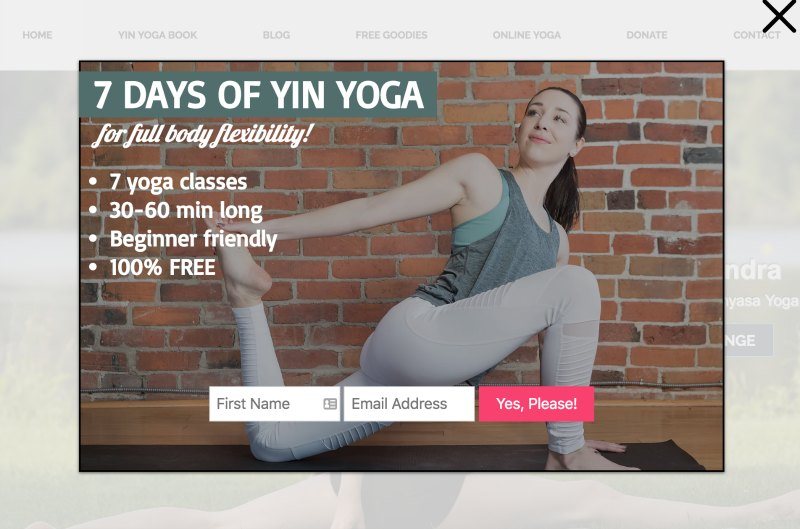
Yoga With Kassandra's 7 Day Yin Yoga Immersion challenge sign up lightbox. She also has a separate landing page she uses for the challenge.
Here’s how Kassandra’s Yin Yoga Immersion challenge plays out after sign up:
1. Automated and Evergreen YouTube Course:
The instructional portion of the 7 Day Yin Yoga Immersion challenge happens through YouTube videos.
2. Email Automation:
Subscribers to the challenge receive a daily email with a link to that day’s Yin Yoga video on YouTube.
Each email also contains secondary calls-to-action including links to buy Kassandra’s new Yin Yoga book and sign up for her free Lunar Yoga for Women webinar. And although the webinar is free, it then soft-sells subscription memberships to Kassandra’s Lunar Yoga Women’s Community.
3. Social Media Following Requests:
Each of Kassandra’s daily emails contain requests and links to follow her on YouTube, Facebook and Instagram. She also provides links in the daily emails to join her Private Yin Yoga Facebook Group.
4. YouTube Video Traffic Generation:
Because most of Kassandra’s yoga audience discovers her on YouTube, new subscribers find the 7 Day Yin Yoga Immersion through links within her YouTube videos. That means people who sign up to Kassandra’s challenge are already fans looking to get their hands on more of what she’s offering – including paid products.
5. Sales Pitches for Physical Products, Paid Courses and Community Membership Subscriptions:
Kassandra’s free 7 Day Yin Yoga Immersion challenge pitches new subscribers a few different paid products throughout the challenge.
Primarily, this includes links to buy her new Yin Yoga book, links to a free webinar that pitches paid membership subscriptions as well as links to premium yoga video courses
Comparing List Building Challenge Strategies
To help give you a higher level view of our list building challenge examples to determine what style would work best for your own online business, we compiled the main elements of each in a comparison table:
Challenge | Industry | # of Days | Live or Automated | Challenge Tools | Frequency | Paid Products |
|---|---|---|---|---|---|---|
Save $1K in 1 Week | Entrepre-neurship | 5 | Automated | Email + Online Course | Every week | Earn $1K On The Side Course |
Live Video Confi-dence | Personal Branding | 5 | Live | Email + Facebook Group | Twice a year | Lights Camera Branding Course |
30 Day List Building | Internet Marketing | 30 | Automated | Email + Online Course | Evergreen | Instant Access to Full Challenge + SaaS Subscription |
Yin Yoga Immersion | Yoga & Fitness | 7 | Automated | Email + YouTube Videos + Facebook Group | Evergreen | Book + Community Membership Subscription + Premium Yoga Courses |
Now to Create Your Online Challenge Funnel
It’s time to take what you learned in this post and rapidly implement your own list building challenge.
Don’t be a perfectionist about it...just get it launched and find ways to improve it based on your new subscriber feedback once it’s up and running.
What kind of list building challenge are you going to build and how will it help lead people into your premium products? Let us know in the comments section below!







Amazing to see Thrive team finally addressing the power of online challenges.
Challengers are currently by far best lead gen and relationship building method available.
For anyone reading the post and loving the idea of using Thrive Architect to launch a challenge:
We’ve been using Thrive (Landing Pages now Architect + Leads) for past year to generate hundreds of thousands of challengers (yes, that many) for our clients across many different markets.
You can’t go wrong, so start planning your successful Thrive powered challenge TODAY!
(btw – I’m not affiliated with Thrive in any way, just love using their products)
Phill
Thanks for your testimonial and sharing your challenge results with us Phill! I’d have to agree the Thrive Architect + Thrive Leads is a powerful combo when it comes to running online challenges to build your email list.
Matt, one suggestion regarding the page template in Architect.
It would be great if you could add thank you page as well to have complete basic challenge funnel.
I can share our top performing simple thank you page if needed.
Thanks Phill. I opted not to create a dedicated Thank You page for this challenge LP template to keep it super simple, but may add one to in the near future.
Great content, great tips and great education. This is yet another guide that could become a step by step tutorial inside Thrive University, showing exactly how to achieve this using the Thrive Tools.
Thanks for sharing.
Thanks Luis! And I agree with your suggestion…this would make a great Thrive University course.
I would be really happy, if you just ones would help us on the B2B marked. Its not quiet another story, but our customers are sitting in a company with very different goals. Most of your advice is for private people wanting to get rich, slim, better confidence, ability to write, be a clever marketer. Try to sell some really expensive and complex, where the profit will go into the pocket of the company and not the employee.
True! Love what you do, but we need more B2B stuff!
Same question to you Rinaldo…can you share a few B2B problems you’re experiencing that we can help you solve?
Thanks for your comment Bjarne. Of course, Thrive Themes is very B2C focused, but we’re keen to learn how we could help you in the B2B world.
Is there a particular B2B problem you could share that would help us focus on creating a super useful piece of content for you?
sorry, but I simply cannot leave this uncommented. If one wants to be a marketer, he / she maybe should use some of their creative power to adapt this.
I’m in a b2b market (procurement and negotiations) as well and can easily adopt those ideas.
Ramit Sethi’s challenge: Save your company $5,000 in 5 days by better negotiation tactics.
Yes, cross selling a premium course would be maybe more difficult but hey, you could usually charge much more. Companies e. g. pay 4figure amounts for online trainings in this area, which is quite difficult, if one is not the typical “Tai Lopez fake guru” follower in the private area.
More effort, yes, but also more gain
Thanks for your comment Philipp! I definitely agree with you that by using a little creativity, we as marketers can modify good B2C strategies to make them work for B2B.
You gave an awesome example of this creative modification in your “Save your company $5,000 in 5 days” suggestion! I’m sure Ramit would be proud! 😉
This is awesome! I have used Thrive Themes to create many challenges, I love that now you have a template. It’s time for me to create a new one lol. Y’all are the greatest!
Thanks Latrice…I hope the new template helps you launch your next challenge ASAP!
This is a great idea. Many thanks
Cheers John!
This is awesome. It falls in line with what I’m working on. Just reading this goes further to tell me I’m doing something that works. Really excited
That’s awesome to hear Enstine…keep up the good work!
Brilliant, thanks a lot for sharing.
Thanks Frank!
Yay!! This looks so exciting and can’t wait to implement this into my business. Love the provision of a template.
Thanks Fay…good luck with your 1st challenge!
Hey Matt!
Superb post, as usual. So you were fired by Active Growth and hired by Thrive Themes? 😉
Haha Martin! The secret is out now…I’m a Thrive Themes/ActiveGrowth double agent ;-P
Wow, well said.
Thanks Joshua!
I’m thunderstruck…more online ecstatic than ever before..Here come’s The Non Exerciser’s Guide and FitPro at Work mobile app wizardry with such amazing list building action..
Thanks for the super teaching graduation present.
Good luck with your online challenge PJ!
I love your page builder tool guys ! So convenient in every day optimisation and AB testing situations 🙂
Thanks Poupy!
Hey Matt, super helpful article. I’ll definitely be using the opt-in template you reference in it.
You mention that Ramit uses dedicated landing pages for each day of his 5DC. Two questions:
1) Can you recommend particular templates in Architect that are especially useful for each day of our challenge?
2) I’m assuming we should avoid predictable URLs for the landing pages so people can’t discover them on their own. I.e., not something like mysite.com/5dc-1, mysite.com/5dc-2. Is that correct?
Thanks again for a top-notch article, Matt!
Thanks Bryan!
To answer your questions:
1) I wouldn’t sweat the landing page design for each day of your 5 day challenge too much. Simple and clear is better than over-designed and clever. Ramit’s daily pages just look like simple blog posts interspersed with simple images to make his points. It’s more important to offer value by teaching and nailing your Calls-To-Action. Any of the basic Thrive Landing Page templates should work fine for you. Pick one and reuse it for visual consistency on each day of your challenge.
2) Funny enough, Ramit did not protect his landing page urls or make them hard to guess. In fact, he actually used:
https://…/challenge-day-1
https://…/challenge-day-2
https://…/challenge-day-3
etc.
You can make them hard to guess if you want, but if someone wants your free info that bad, let ’em have it and they’ll get to your big end-of-challenge CTA that much faster! If you’re running a real time challenge however (like in Coach Glitter’s example), publish each new day in real time so they can’t skip ahead…in that situation it definitely matters.
If you’re not in the Internet Marketing niche though, most people won’t really know how to guess the next day URL so it’s probably no big deal at all.
Hey Matt, this got filtered, so just seeing now. Thanks for a thorough, helpful reply!
Glad you finally got a chance to read it Bryan…thanks for your comment!
I really like Thrive Architect, easy to use with plenty of features. I don’t regret my investment. I created my leadpage with thrive architect and really like the professional design.